|
Finding information
on the Osgood Lens, invented by James R. Cravath, is challenging. For as prominent
as it was in magazines like The Saturday Evening Post in the late 1910s
and 1920s, there is not even a Wikipedia entry for the lens type or the man according
to my searches. Although not exactly the same as the
Fresnel lenses used by lighthouses since the 18th century, the
concept is basically the same. Of course the Osgood company was careful not to use
the term Fresnel in their literature for potential patent infringement reasons.
Some vehicles might have been fitted with them as a factory installed option, but
they were also sold as add-on items. According to the literature the tiered stack
of prism-shaped glass directed the headlight beam toward the road in a manner that
allowed full-time use of a high intensity beam setting at all times. It removed
the need to dim your headlights when another vehicle approached in order to avoid
blinding him (likely not a "her" driving in 1917). Here is a report on a radio
frequency (RF) form of the Osgood lens designed by
Bell Telephone Labs in a 1946 issue of Radio-Craft magazine.
As with so many things, Osgood Lenses are available for purchase on
eBay if you
have been looking for one to trick out your car or truck. You would need to either
own a vintage vehicle that had round headlights or have one of the few that still
use them today (e.g., the 2005-2012
Ford Mustang).
Osgood Lens Advertisement
 The New Osgood Lens - the lens with the
twelve prisms that operate as one. The New Osgood Lens - the lens with the
twelve prisms that operate as one.
Officially sanctioned by the authorities of America's principal cities.
Osgood Lenses for Sale on eBay

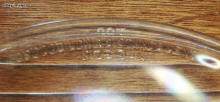

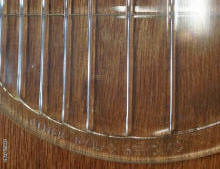
Osgood Lens for sale on eBay
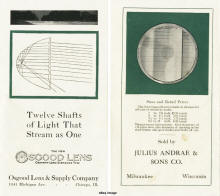
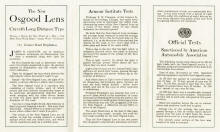
Osgood Lens Brochure (eBay image)
America's recognized authorities on illumination can be counted on the fingers
of one hand. The group includes James R. Cravath, headquarters, Chicago. To this
man is due the discovery of the principle embodied in the New Osgood Lens - Cravath
Long Distance Type - by which 74% more light is thrown onto the road, as compared
with the light from a lens of plain glass. Besides delivering this more powerful
road ray, the New Osgood Lens abolishes glare, because the ray is not more than
waist high. The road is lighted for the full distance of one-third of a mile. The
small diagram on the next page shows a side view of the twelve selective prisms
of the New Osgood Lens which deliver the light to exact predetermined road points,
while the rays merge to form the one master shaft of light which shows the "going"
far ahead. Efficiency and courtesy combined.
He Revolutionized Light for Motorists
Gave them 74% More Light on the Road - A Waist-High Beam - Light Thrown 1/3 Mile
Ahead of the Car - No Glare - No Need for Dimming
In the New Osgood Lens, James R. Cravath has brought to motorists a new night-driving
efficiency, comfort, safety, ease-of-mind. In the New Osgood Lens he has converted
"sky" rays into road rays by directing them all downward toward Mother Earth.
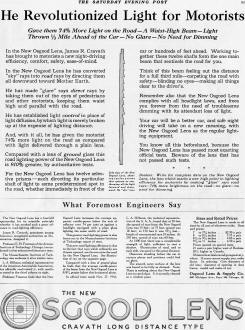 He has made "glare" rays direct rays by
taking them out of the eyes of pedestrians and other motorists, keeping them waist
high and parallel with the road. He has made "glare" rays direct rays by
taking them out of the eyes of pedestrians and other motorists, keeping them waist
high and parallel with the road.
He has established light control in place of light diffusion, by which light
is merely broken up at the expense of lighting distance.
And, with it all, he has given the motorist 74% more light on the road as compared
with light delivered through a plain lens.
Compared with a lens of ground glass this road lighting power of the New Osgood
Lens is 910% greater, by authoritative tests.
For the New Osgood Lens has twelve selective prisms - each directing its particular
shaft of light to some predetermined spot in the road, whether immediately in front
of the car or hundreds of feet ahead. Working together these twelve shafts form
the one main beam that sentinels the road for you.
Side view of the New Osgood Lens, showing twelve prisms that operate as one,
throwing all the light forward and downward. No "sky" rays
Think of this beam feeling out the distance for a full third mile - carpeting
the road with safety - blinding no eyes - making all things clear to the driver's.
Remember also that the New Osgood Lens complies with all headlight laws, and
frees you forever from the need of troublesome dimming with its attendant loss of
light.
Your car will be a better car, and safe night driving will take on a new meaning,
with the New Osgood Lens as the regular lighting equipment.
You know all this beforehand, because the New Osgood Lens has passed most exacting
official tests. Beware of the lens that has not passed such tests.
* * *
Dealers: Write for complete data on the New Osgood Lens, the lens which marks
a new high point in lighting efficiency for motorists by making "glare" rays road
rays - 74% more brightness on the road - no glare - no need for dimming.
What Foremost Engineers Say
The New Osgood Lens has a fourfold sponsorship for its scientific principle whereby
it has marked such a great advance in road-lighting efficiency.
James R. Cravath, prominent among America's recognized authorities on illumination,
designed it.
Professor E. H. Freeman of the Armour Institute of Technology, Chicago, has endorsed
it after exhaustive laboratory tests.
The Massachusetts Institute of Technology also endorses it after similar tests.
L. A. Hillman. technical representative of the American Automobile Association,
has officially road-tested it, with results as noted in the third column to right.
Professor Freeman finds that the New Osgood Lens increases the average apparent
candle-power below the axis of reflector over 74 per cent as against a headlight
equipped with a plain glass lighting the same width of road.
This greater road-lighting power is also borne out in the Massachusetts Institute
of Technology report of tests.
This new road-lighting efficiency is due to the fact that rays which ordinarily
are thrown upward, are thrown onto the road by the New Osgood Lens. See illustration
of rayon the opposite page.
Compared with a lens of ground glass he finds that the average candle-power of
the beam from the New Osgood Lens is 910% greater below this horizontal plane.
In official tests made Nov. 27. 1916, L. A. Hillman, the technical representative
of the A. A. A., found that at 50 feet the spread of rays from the New Osgood Lens
was 15 feet; at 75 feet, spread was 18 feet; at 150 feet it was 35 1/2 feet - height
of concentrated rays 24 inches. At 250 feet, spread of rays was 60 feet.
At 1800 feet there was a considerable strength of light, sufficient to cast a
shadow. Illumination of road, and to each side, was good at this great distance.
Observers standing before the car in various places and positions could find
no glare.
The smooth outer surface of the lens was found to be fully as claimed. Note:
There is nothing about the New Osgood Lens to catch dust. It is as easily cleaned
as a window pane.
Sizes and Retail Prices
The New Osgood Lens is made in all sizes for all cars of whatever make. Sizes
and prices:
7 to 7 3/4 inches
$2.90 a pair
8 to 8 1/2 inches
$3.75 a pair
8 3/4 to 9 1/2 inches
$4.00 a pair
9 3/4 to 11 inches
$4.50 a pair
Prices quoted on special sizes.
25 cents a pair higher west of Rockies. 20% higher in Canada.
Obtainable at dealers and garages everywhere. I f yours cannot supply you, order
direct. In ordering: Give diameter of old lens; diameter of opening in door frame;
model and make of car.
Osgood Lens & Supply Co.
2007 Michigan Ave., Dept. 908, Chicago, Ill.
The New Osgood Lens Cravath Long Distance Type
Posted August 6, 2019
|

















